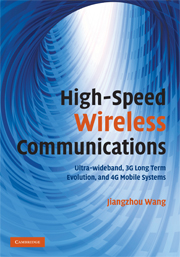Book contents
- Frontmatter
- Contents
- Preface
- Acknowledgements
- List of abbreviations
- Part I Introduction
- Part II UWB communications
- 2 Multicarrier CDMA overlay for UWB communications
- 3 Impulse radio overlay in UWB communications
- 4 Rapid acquisition
- Part III Evolved 3G mobile communications
- Part IV 4G mobile communications
- Index
- References
3 - Impulse radio overlay in UWB communications
from Part II - UWB communications
Published online by Cambridge University Press: 27 May 2010
- Frontmatter
- Contents
- Preface
- Acknowledgements
- List of abbreviations
- Part I Introduction
- Part II UWB communications
- 2 Multicarrier CDMA overlay for UWB communications
- 3 Impulse radio overlay in UWB communications
- 4 Rapid acquisition
- Part III Evolved 3G mobile communications
- Part IV 4G mobile communications
- Index
- References
Summary
Interference suppression is important to allow UWB devices to operate over the spectrum occupied by narrowband systems. In this chapter, the use of a notch filter in TH-IR for UWB communication is considered, where a Gaussian monopulse is employed with pulse position modulation (PPM). A lognormal fading channel is assumed and a complete analytical framework is provided for performance evaluation using a transversal-type notch filter to reject narrowband interference. A closed-form expression of BER is derived, and the numerical results show that the use of a notch filter can significantly improve system performance. Furthermore, a performance comparison between TH-IR and multicarrier CDMA UWB systems is also made for the same transmit power, the same data rate and the same bandwidth. It is shown that, in the presence of narrowband interference, the TH-IR system with a notch filter can achieve a performance similar to multicarrier CDMA.
Introduction
Over the last decade, there has been a great interest in ultra-wideband (UWB) time-hopping (TH) impulse radio (IR) communication systems [1–8]. These systems make use of ultra-short duration pulses (monocycles), which yield ultra-wide bandwidth signals characterized by extremely low power densities. UWB systems are particularly promising for short-range high-speed wireless communications as they potentially combine reduced complexity with low power consumption, low probability of intercept, high accuracy positioning and immunity to multipath fading due to discontinuous transmission.
- Type
- Chapter
- Information
- High-Speed Wireless CommunicationsUltra-wideband, 3G Long Term Evolution, and 4G Mobile Systems, pp. 68 - 91Publisher: Cambridge University PressPrint publication year: 2008



